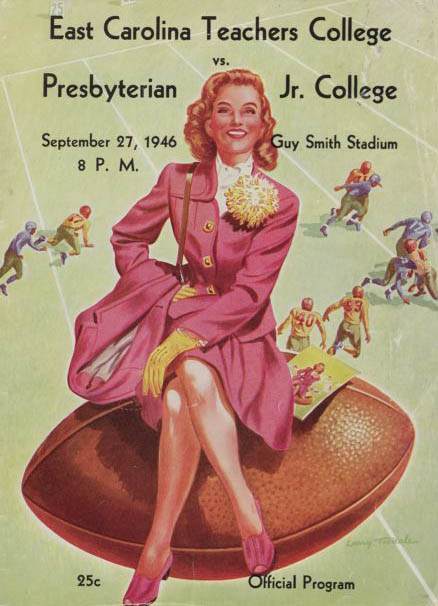
September 27, 1946
East Carolina Teachers College played its first post-WWII football game on September 27, 1946, reviving the popular sport from a four-year period of wartime dormancy. In 1942, following a stellar year with an undefeated Pirate team, East Carolina had to suspend intercollegiate varsity football due the inability of head coach John Christenbury to put together a full schedule. Wartime exigencies had prompted other schools to suspend football, leaving the Pirates without significant intercollegiate competition. As a result, East Carolina followed suit in the fall of 1942. Four years later, with an influx of GI’s at schools across the land, varsity gridiron competition resumed in short order. Tragically for East Carolina, however, former head coach John Christenbury had died in service to his country during the war. As things turned out, the postwar Pirate team, led by a new head coach, James A. “Jim” Johnson, easily defeated PJC by four touchdowns and two conversions, 26-0, continuing the undefeated string that was Christenbury’s historic legacy from the fall of 1941. The Pirate victory was the first of five, and a winning record, 5-3-1.
Prior to the game, ECTC cheerleaders held their “first pep meeting of the fall sports season … in preparation for the initial gridiron contest, leading a group of about 200 football fans, plus the football players, through a number of yells and college songs, both old and new.” The pep meeting was held “back of Wright Field around a blazing bonfire.” According to the Teco Echo, “those who missed it should have been there to share the school spirit.” Clearly football was back in business, perhaps stronger than ever in the wake of the war.
Wright Field, on the main campus, had been the home for earlier Pirate football practice and intercollegiate play. However, 1946 marked a new beginning, one wherein the Greenville municipal stadium, Guy Smith Stadium, located across town in west Greenville, served as the home gridiron. The stadium, originally meant for baseball rather than football, was dedicated in 1937 in honor of the president of the local baseball club in Greenville, Guy Smith, affectionately known as “the daddy of baseball in Greenville.” With an initial capacity of 2,000 and an additional 1,306 in the grandstands, Guy Smith Stadium was easily enough retooled for Pirate games during the fall of 1946. This arrangement continued for the remainder of the decade, until Pirate supporters led by Ed Rawl raised funds for the construction of a new facility, on the east end of campus, known as College Stadium. A week after the victory over the Scots, the Bucs played Atlantic Christian College for the first clash between the two rivals since 1941. The game, ending in a 6-6 tie, was also played at Guy Smith Stadium before a crowd of reportedly 3,000 fans.
The Pirates’ 1946 schedule also included games against Elon (away), October 12; Erskine (home), October 19; Newport News Naval Apprentice School (home), October 26; Atlantic Christian College (away), November 9; Western Carolina Teachers College (homecoming), November 16; and Lenoir Rhyne (away), November 22; and Fort Bragg (away), November 28.
Head coach Johnson offered his vision of Pirate athletics by stating, “The main purpose of our athletic program is to furnish an opportunity for the many GI’s and other men students to take part in a vigorous and entertaining sports program and to give the other students a chance to see their school teams compete against other small college teams. I think the athletic program will have a wholesome effect upon the morale of the school, and will do much to establish a bond of unity and a feeling of oneness so necessary for the development of a spirit of loyalty and devotion.”
Coach Johnson was right. There can be no question that resumption of gridiron competition in the fall of 1946 helped contributed to the unity of the campus and community. It was, moreover, a momentous occasion in the history of East Carolina and the Pirate nation.
Sources
- “1946 Gridiron Candidates.” Teco Echo. Vol. 21, no. 4. August 21, 1946. P. 3. https://digital.lib.ecu.edu/38124
- “Coach Johnson Gives Football Dope On Season.” Teco Echo. Vol. 21, no. 4. August 21, 1946. P. 1. https://digital.lib.ecu.edu/38124
- “East Carolina Drops Varsity Football.” Teco Echo. Vol. 18, no. 1. October 9, 1942. P. 3. https://digital.lib.ecu.edu/37908
- “East Carolina Teachers College vs. Presbyterian Jr. College.” September 27, 1946. University Archives # UA40.01.02.02.01. J. Y. Joyner Library. East Carolina University. Greenville, N.C. https://digital.lib.ecu.edu/27613
- “ECTC Ties ACC, 6-6. In First Clash Since 1941.” Teco Echo. Vol. 22, No. 1. October 11, 1940. P. 3. https://digital.lib.ecu.edu/38125
- “First Pep Meeting.” Teco Echo. Vol. 22, No. 1. October 11, 1940. P. 3. https://digital.lib.ecu.edu/38125
- “Football Begins September 2: Pirates Open With P.J.C. In Greenville.” Teco Echo. Vol. 21, no. 4. August 21, 1946. P. 1. https://digital.lib.ecu.edu/38124
- “Pirates Win First, Tie Second: Pirates Win Over P.J.C. Scots In Opening Game.” Teco Echo. Vol. 22, No. 1. October 11, 1940. P. 3. https://digital.lib.ecu.edu/38125
- “Six Engagements Remain On Pirates 1946 Schedule.” Teco Echo. Vol. 22, No. 1. October 11, 1940. P. 3. https://digital.lib.ecu.edu/38125